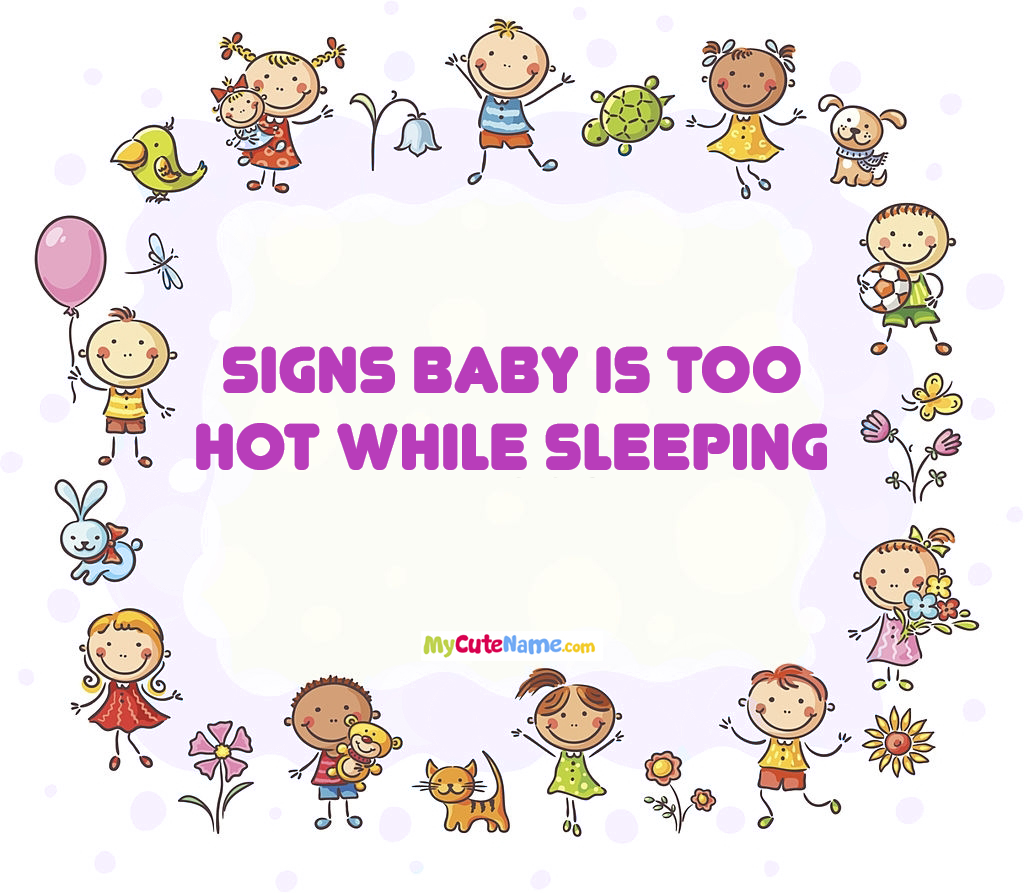


Introducing the signs that a baby may be too hot while sleeping brings attention to an important aspect of infant care and safety. As caregivers, ensuring the comfort and well-being of babies during sleep is paramount, as overheating can pose risks to their health. Recognizing the signs of overheating is crucial for maintaining a safe sleep environment and preventing potential discomfort or complications. By understanding these signs, caregivers can take proactive steps to adjust the baby's sleep environment and ensure optimal conditions for restful sleep. Let's explore some common signs that indicate a baby may be too hot while sleeping, empowering caregivers to provide the best possible care for their little ones.
Why do babies overheat?
Newborns and young infants are particularly vulnerable to fluctuations in body temperature due to their underdeveloped thermoregulatory system. Unlike adults or older children, their ability to efficiently regulate body temperature is still developing, leaving them at risk of both overheating and becoming too cold. In fact, infants lose body heat at a rate four times faster than adults or older children, underscoring the importance of maintaining a balanced environment for their comfort and safety.
Babies possess a higher metabolic rate compared to adults, resulting in increased heat production. However, if they are exposed to an environment that is excessively warm or bundled up in layers of clothing, their body temperature can escalate rapidly. Furthermore, infants have a limited capacity to sweat relative to adults, as their smaller sweat glands and reduced sweating ability hinder their ability to cool down, particularly during the early months of life.
Given these vulnerabilities, caregivers must remain vigilant of their baby's surroundings to prevent overheating. Simple measures such as dressing infants in lightweight, breathable clothing, ensuring proper ventilation in their sleeping area, and avoiding direct exposure to sunlight or excessive heat can help mitigate the risk of overheating. Additionally, it is essential for caregivers to be attuned to signs of discomfort, as infants may not be able to communicate their distress effectively. Monitoring for cues such as shivering to indicate cold, attempts to remove clothing when hot, or excessive sweating can provide valuable insights into the baby's comfort level and help prevent overheating-related complications.
Causes of Overheating Babies at Night
Ensuring a baby’s comfort and safety during sleep involves vigilant monitoring of their temperature to prevent overheating. Watch for signs like flushed skin, excessive sweating, rapid breathing, irritability, or lethargy, as these may indicate the baby is too hot. Overheating can stem from various factors, including:
Excessive Clothing and Bedding: Avoid dressing the baby in too many layers or using heavy blankets, as this can lead to overheating. Consider the ambient temperature and dress the baby appropriately while keeping the bed clear of loose blankets.
Room Temperature: Maintaining the baby’s sleeping environment at an ideal temperature is crucial. Aim for a room temperature between 68°F to 72°F (20°C to 22°C) and use a room thermometer to monitor and adjust as needed.
Inadequate Ventilation: Poor air circulation in the baby’s room can trap heat and contribute to overheating. Ensure proper ventilation by using fans or opening windows when necessary.
External Heat Sources: Be mindful of external heat sources in the baby’s sleeping area, such as radiators or heating pads, which can exacerbate overheating. Keep the sleeping space free from such sources.
Illness or Fever: Babies who are unwell or have a fever may be more prone to overheating due to elevated body temperature. Seek guidance from a healthcare professional on managing the baby’s temperature if they are sick. By addressing these factors and staying attentive to the baby’s needs, caregivers can help ensure a safe and comfortable sleep environment.
How do I know if my baby is overheating?
During the hot summer months and extending into the fall, parents in states like Texas and California often face challenges in keeping their babies cool at night. Ensuring that their little ones are comfortable and safe during sleep requires parents and guardians to be well-informed and equipped with the necessary tools. Recognizing signs of overheating is crucial.
Some signs that a baby may be too hot include:
If your baby is unwell, it is essential to seek guidance from a healthcare professional.
HOW DO I PREVENT OVERHEATING MY BABY AT NIGHT?
While you can’t control the weather outside, you can manage the conditions inside your baby’s room. Ideally, the room temperature should be between 68 and 72 degrees Fahrenheit (20 to 22.2 degrees Celsius).
Even if you can’t measure the exact temperature, ask yourself, “Is this room too hot or too cold for me?” Babies have similar comfort needs to adults; if it’s too warm for you, it likely is for them as well.
To keep your baby’s room cool, consider the following tips:
HOW DO I PREVENT OVERHEATING MY BABY AT NIGHT?
Ensuring your baby stays at a comfortable temperature during the night can improve sleep for both of you. Parents can adopt various strategies to prevent their baby from overheating at bedtime.
Room Temperature
While you can't control the outdoor weather, you can manage the indoor environment in your baby’s room. The ideal room temperature for a baby is between 68 and 72 degrees Fahrenheit (20 to 22.2 degrees Celsius).
If you can’t measure the exact temperature, simply ask yourself, “Is it too hot or too cold for me in here?” Since babies have similar comfort needs, if it's too warm for you, it likely is for them as well.
Here are some tips to keep their room comfortably cool:
Safe Sleep Habits
Ensuring your baby sleeps safely is essential. This involves placing babies to sleep with their head and face uncovered. Since infants regulate their temperature through these areas, avoiding hats, bonnets, beanies, or blankets is crucial to prevent overheating and potential suffocation if these items slip during the night.
The American Academy of Pediatrics (AAP) also recommends the following safe sleep practices:
Appropriate Bedding
Regardless of the temperature, experts advise against using any loose bedding for infants. The American Academy of Pediatrics (AAP) recommends avoiding soft bedding, including crib bumpers, blankets, pillows, and soft toys. These items not only pose a suffocation risk but can also increase the baby's temperature, leading to overheating.
Instead of loose blankets or quilts, parents should consider:
IDEAL TEMP SWADDLES & WEARABLE BLANKETS
Some swaddles, such as the Swaddle Ideal Temp, and certain wearable blankets, like the Ideal Temp Wearable Blanket, utilize specialized fabric to help regulate a baby's temperature. The IntelliThread™ technology in these products absorbs heat, stores it, and then releases it back to your baby, maintaining an optimal temperature and preventing overheating.
Swaddling is generally recommended for infants until they can intentionally roll over, usually around 3-4 months old. After this stage, many parents switch to using a swaddle that allows the infant's arms to be free or a sleep sack. A sleep sack, or wearable blanket, is typically crafted from breathable fabric to keep a child comfortable and warm without the risk of overheating. It also eliminates the need for loose fabrics that can pose safety hazards.
Appropriate Clothing
When dressing your baby for bedtime, a good rule of thumb is to add one more layer than what you are wearing. In the warm summer months, if you’re sleeping in minimal clothing, you should avoid dressing your baby in heavy fleece footie pajamas. Here are some options to consider for summertime:
It’s important to err on the side of caution and avoid overdressing your baby. It’s easier and safer to add a layer during the night if needed. Additionally, you should never put an infant to bed with any type of hat, bonnet, or beanie. These items can prevent heat from escaping through the head, leading to overheating, and they can pose a risk of falling over the baby’s face and obstructing breathing.
Remember, although you might want to keep your baby snug and warm, infants cannot regulate their own temperature effectively. During the warm summer months, it is crucial to practice safe sleeping habits to ensure your baby sleeps comfortably through the night without becoming too hot.
What to do if Your Baby is Overheating
Check Temperature:
Seek Medical Attention:
Move Your Baby to a Cooler Space
If you observe that your baby is getting too warm, move them to a cooler environment to prevent further overheating. This can involve drawing curtains or blinds to keep the room cooler and shifting them to a different room or area in the house. If the baby’s room is upstairs and too hot, consider relocating them to a cooler room on a lower floor.
Give Your Baby a Bath or Apply a Cold Compress
If your baby is too warm, a lukewarm bath or applying a cool washcloth to their skin can help lower their body temperature. Letting them play in a shaded paddling pool is another great method to keep them cool. Additionally, using a cold, damp flannel to cool your baby in hot weather offers a quick and effective solution.
Signs baby is too hot while sleeping
In conclusion, ensuring your baby sleeps at a comfortable temperature is crucial for their safety and well-being. Recognizing signs of overheating, such as warm skin, rapid heartbeat, and restlessness, allows parents to take prompt action to cool their baby down. By maintaining an optimal room temperature, dressing your baby appropriately, and following safe sleep practices, you can help prevent overheating and ensure a restful night for both your baby and yourself. Always remain vigilant and consult a healthcare professional if you notice any concerning symptoms.
Note: Please also check your spam or junk email folder.